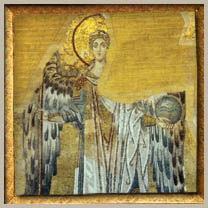There are two archangels in the bema of Hagia Sophia, of one only the feet nd the tips of the wings survive, the other is almost fully preserved


 New Introductionby Bob AtchisonBaroness Sophie Buxhoeveden became one of 200 honorary ladies-in-waiting to the Empress Alexandra and first served at court in November 1904. Later in 1913 as a mark of confidence and special honor she became an official lady-in-waiting and served at the side of the Tsaritsa and her family until their removal from Tobolsk to Ekaterinburg in 1918. During these five years she enjoyed a degree of intimacy and trust from Alexandra that was only matched by two other women, Countess Nastinka Hendrikova and Anna Vyrubova. She was perfectly suited for the job, speaking fluent English, having been raised in an aristocratic household and possessing beauty and charm. Being a young woman at the time she had not yet been drawn into the politics of court life and her innocence in such matters made her immune from any association with any of power cliques which surrounded the throne. Her first visits to serve in the palace were a shock. Sophie had not expected the degree of intimacy between the Empress, her husband and children and their style of living. She found herself thrust immediately into the family circle when the Empress handed the three month old little Tsarevich for her to hold. As a proud mother Alexandra was eager to show off her son to everyone around her and it gave some trepidation to the nervous new lady-in-waiting to be holding the Heir to the Russian Throne in her arms within minutes of arriving in the Empress's rooms for the first time. Sophie's first period of service was six weeks. She did not return to service until the summer of 1911 when she was summonded to join the family on a cruise on the Imperial yacht Standard in Finnish waters. In March 1912 the Empress requested Sophie come to the newly-built Lividia Palace for two months at her side. The Empress's staff had four official ladies-in-waiting. On November 20, 1913 Sophie received her diamond "A" badge from the Empress and became one of this elite group, along with Nastinka Hedrinkova, Lily Oblensky, Sonia Orbeliani and Olga Butsow (who was about to leave to get married). Sophie's early life and an account of this period can be found in a book Sophie wrote called "Before the Storm". Sophie found herself spending a great deal of time with the family and was especially relied upon by Alexandra to escort her daughters outside the palace. She became very close to the Grand Duchesses and was more a friend than a person in an official position. In 1917 Sophie was a witness to the terrible days of the Revolution and was close by the Empress during most of the noteworthy events. She followed the family into Siberian exile in Tobolsk, but was forbidden by the Bolsheviks to accompany the family to Ekaterinburg, where the Romanovs were brutally murdered on the night of July 16/17, 1918. Most of those close to the family - especially those of aristocratic background like Sophie - who followed the family into exile were executed by the Bolsheviks. In one of the mysteries of the time Sophie was not arrested by the Bolsheviks and made her way with many of the family's remaining staff through Siberia and then abroad. She wrote of these experiences in another book "Left Behind". Sophie moved on to Western Europe. She found herself working closely with Alexandra's Hessian family and was involved in the controversy surrounding the false Anastasia, Anna Anderson. Her book writing followed the success of Anna Vyrubova's book "Memories of the Russian Court", Pierre Gilliard's "Thirteen Years at the Russian Court" and Lili Dehn's "The Real Tsaritsa". Although the primary motivation for her own book was to correct what she felt was an inadequate presentation of the Empress's life, the financial benefits were also important - these books were very successful and earned considerable funds for their authors. Money was of great concern for Sophie, she had no means of income outside Russia and had been virtually destitute since leaving Russia and completely dependent on the charity of others. Sophie's careful research makes her work different from Anna Vyrubova's and Lili Dehn's books which are essentially personal narratives of their own experiences. In Buxhoeveden'account she lays out all of the events of the Empress's life from birth to death and made a point of conducting first-hand interviews with many of the important characters of Alexandra's early life. She was given access to the Grand Ducal archives in Darmstadt and to the letters of Alexandra's English governesses which helped her gain a unique perspective on the Empress's origins. It must be said that Sophie's book is meant as a attempt at public advocacy - she wanted the world's negative image of Alexandra to be changed by her presentation of the personal side of her life. It is obvious that she avoids direct criticism of the Empress's actions and attempts to provide background where ever possible to explain the reasons for Alexandra's conduct or decisions. She did this with the discretion she had been trained in as a lady-in-waiting. She avoids all extremely personal or embarassing things she may have observed that do not relate to the events she is describing. There is no mention of the intimate personal habits or foibles of human nature that fascinate Royal reporting in our own era. Sophie presents here picture of the Empress's life with a sense of dignity and decorum - always obliquely aware of her eventual martyrdom in the Ipatiev cellar. Eventually Sophie moved on to England and became attached to Alexandra's sister Victoria's establishment at Milford-Haven. Later she inhabited a grace-and-favor apartment in one of the English Royal palaces. Her rooms were crammed with the memorabilia of her life and the Imperial Family as well as dozens of ash-trays to accommodate her chain-smoking habit. Sophie died in England, I don't have the exact date of her death. Many of her things are now at the University of Southhampton. I decided to put this book on the Internet because it is virtually unavailable to the public and it contains an unmatched record of Alexandra's life from someone who knew her well. I hope you will enjoy reading it and it will give the visitor to the site a better understanding of the life and character of Alexandra. Bob Atchison
 Above: Bob Atchison in front of the Alexander Palace. |
|
Alexandra Feodorovna was the last Romanov Empress of Imperial Russia. This online book - The Life and Tragedy of Alexandra Feororvna was written by Countess Sophie Buxhoeveden, Lady-in-Waiting to the Empress, who served the Empress for many years and followed the Imperial family into exile. |

- Early Surroundings
- Childhood
- A Young Princess
- Engagement
- Marriage
- Her New Home
- Coronation
- Journeys
- Charities and Life
- Queen Victoria
- Foreign Trips
- Birth of Alexis
- Gathering Clouds
- On the Standart
- Rasputin
- Her Family
- Empress at Home
- Last Years of Peace
- Wartime 1914
- War Work
- Without the Emperor
- Visits to Headquarters
- Before the Storm
- Warning Voices
- Rasputin's Murder
- Revolution 1917
- Abdication of the Emperor
- Prisoners
- Five Weary Months
- Tobolsk
- Ekaterinburg 1918





